From its vast,arid,fragile and seemingly endless plains,Genghis Khan’s armies once ruled an empire. But deep beneath his ancient homeland,more than one kilometre underground,an equally huge undertaking is unfolding.

Komatsu dump trucks at the Oyu Tolgoi open-pit mine.Bloomberg
Twenty-thousand workers are labouring 24 hours a day,365 days a year to unlock the most valuable part of the Oyu Tolgoi mine,one of the world’s most remote mining operations run by Anglo-Australian resources giant Rio Tinto.
At stake is supply of a key mineral for the global transition to a low-carbon economy:copper.
The valuable Oyu Tolgoi mine is a hive of activity. Pit trucks rumble day and night,crushers grind rocks through the dark hours,huge metal concentrator vats bubble relentlessly refining copper ore. Workers take rotating shifts bagging the final copper concentrate product as stars twinkle in the desert sky. Temperatures plunge 40 degrees below zero in winter and the same above in summer.
Hundreds of workers on 14-day rotations are housed on site,either in traditional gers (yurts) or modern triple-storey demountable units. They dine in a communal kitchen hall that churns out 21,000 meals a day.
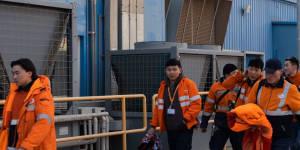
Hundreds of workers on 14-day rotations are housed on site.SeongJoon Cho/Bloomberg
About 97 per cent of the mine’s workforce are Mongolian,about one-fifth are female,and a third are from local communities – impressive statistics in a known for flying in and flying out skilled workers.
Copper is a key base metal for the global transition to a low-carbon economy,critical for electrification and clean energy infrastructure. Rio has been extracting gold and copper from Oyu’s open-cut operations since 2012,but is now proceeding with the more technically challenging task of extracting the mineral from deep below the surface – unlocking the most valuable part of the mine. Using “block-carving” techniques,it collects the falling mineral ore from shafts 1.3 kilometres underground and then transports it up a conveyor to the surface for processing.
The miner positions itself as a responsible,transparent operator. For example,Oyu’s materials sourcing program buys personal protective equipment made by local co-operatives. Nevertheless,the underground mine was beset by a series of long delays and cost blowouts after construction began in 2019,compounded by a long-running dispute with the Mongolian government that only ended last year when Rio waived a $US2.4 billion ($3.6 billion) debt owed by the government.
“It’s not been a smooth ride. Let’s be honest about that. We have had our challenges,we have had our setbacks,” Rio Tinto chief executive Jakob Stausholm says.
And tensions remain – chiefly a fight over the company’s tax liability. Rio has a 66 per cent stake in Oyu,the government has 34 per cent. “It takes two to tango. There was no way we could solve everything in one go,” Stausholm says.
Bulgantuya Khurelbaatar,Mongolia’s border ports minister and a former employee of the mine,isn’t giving ground though. Locals won’t be happy if the government treats big Western investors differently to them,she says.
“We will try,of course,to be amicable. But at the same time,we also have to ensure that because this is the first large project,and lots of other big mining projects are looking at how we’re going to be resolving this issue;it’s going to probably set a precedent.
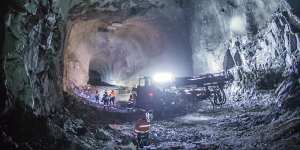
Excavating access tunnels deep underground at the Oyu Tolgoi copper mine.Supplied
“This was the first big project in a country that is nomadic and very dependent on agriculture,” she says. “We have a much more shamanistic kind of culture where we pay homage to the Mother Earth. It’s quite difficult to endorse mining.”
But it’s Mongolia’s authoritarian and assertive neighbours,China and Russia,that really hold the keys to the success of Rio’s $7 billion bet on the mine’s new underground operation. Along with its host country,the company is squeezed between two unstable geopolitical fault lines.
Rio was quick to when the West imposed severe economic sanctions after Moscow marched on Kiev,triggering the ongoing deadly Ukrainian conflict that has upended Europe and sparked a global energy crunch.
“We went out as the first mining company saying we would cut our commercial ties to Russia,and we’ve done so,and it wasn’t easy,” says Stausholm. “It’s really not our job to tell countries what you do.”
But the mine’s huge Komatsu haulage trucks – the size of a large two-storey house – which carry 290 tonnes of ore in each load as they climb out of the 650-metre deep open-cut pit,are thirsty consumers of diesel. And the hundreds of 4WD vehicles,heavy machinery,semi-trailers and buses used to move people and goods around the mine and open-cut pit – which will eventually stretch nearly 3 kilometres in length – also suck up huge quantities of fuel.
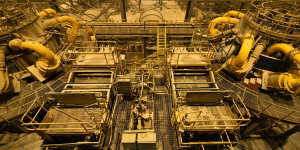
The copper ore is processed in a vast crushing,concentrator and packaging complex.SeongJoon Cho/Bloomberg
The mine’s huge energy needs – equivalent to about a quarter of Mongolia’s production capacity – are dependent on electricity from China and fuel from Russia.
Khurelbaatar says the mining sector,in which Rio is by far the largest player,accounts for half of the nation’s entire petroleum use.
Diesel and fuel is all imported from Russia. There is no other option. “What are the choices?” Khurelbaatar says. Recognising its vulnerability and lack of energy security,Mongolia is constructing its first refinery,she adds.
Rio’s copper boss,Bold Baatar,is more blunt. “It’s a work in progress. Russia does not supply us directly. We buy our goods from Mongolian suppliers,and look for alternative suppliers from many parts of the world. This is something that we are working on,” he says.
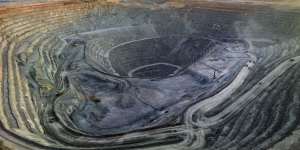
The open pit mine at the Oyu Tolgoi copper-gold prospect.SeongJoon Cho/Bloomberg
It’s a similar story with the mine’s relationship to China.
The copper ore yielded up by the Gobi Desert is processed in a vast crushing,concentrator and packaging complex. Oyu’s concentrator is so large,it claims the title of the biggest industrial unit ever built in Mongolia. When the one-tonne bags of concentrate emerge from the facility’s bagging plant,they are just 100 kilometres by road to the nearest border point with China.
And that’s where nearly all of it is shipped.
Of the 25 million tonnes of copper consumed globally,China gobbles up about 13.6 million tonnes. North America processes about 2.4 million and Europe 3.7 million. Presently,Oyu produces 130,000 tonnes of copper concentrate a year,a figure that is expected to jump to 500,000 when the mine’s new underground shafts hit full capacity from 2028 to 2036. When it reaches that pitch,it will supply two per cent of world demand and be the globe’s fourth-largest copper mine.
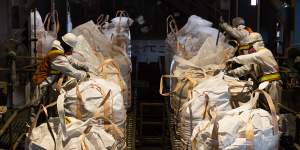
Workers tie bags of copper concentrate in the bagging plant at the Oyu Tolgoi copper-gold mine.SeongJoon Cho/Bloomberg
“[We live] in the world where everything that we do – drive a Tesla or use an iPhone – needs copper and most of that,like it or not,is manufactured in China,” says Baatar.
It’s a dependence that neither he nor Stausholm shy away from.
“There’s a lot of trade with China. We buy power[from them],we sell[them] copper concentrate,” Stausholm said. “We have a very big business into China. I’m not particularly worried from our standpoint as you’re seeing China opening up right now. Mongolia is geographically very close to China,and that’s where we are selling the copper concentrate,” he said.
Rio’s dependence on Chinese energy may be offset in the future by an agreement to source power from the Mongolian grid. Stausholm said Rio was also intent on expanding renewable energy generation for the mine.
Oyu’s expansion is one of the mining giant’s most important growth projects – a key plank in its ambition to diversify away from iron ore and push deeper into minerals that will increasingly be needed in a low-carbon economy.
“There’s a lot of talk about battery materials,but if you really do your numbers,you will see the big numbers are in copper and aluminium. From an environmental point of view,you’ll see these super-scale copper mines are the most efficient[way to extract that],rather than a lot of smaller,older mines,” Stausholm says.
The reporter travelled to Mongolia as a guest of Rio Tinto.
The Business Briefing newsletter delivers major stories,exclusive coverage and expert opinion..